Page 183 of 335
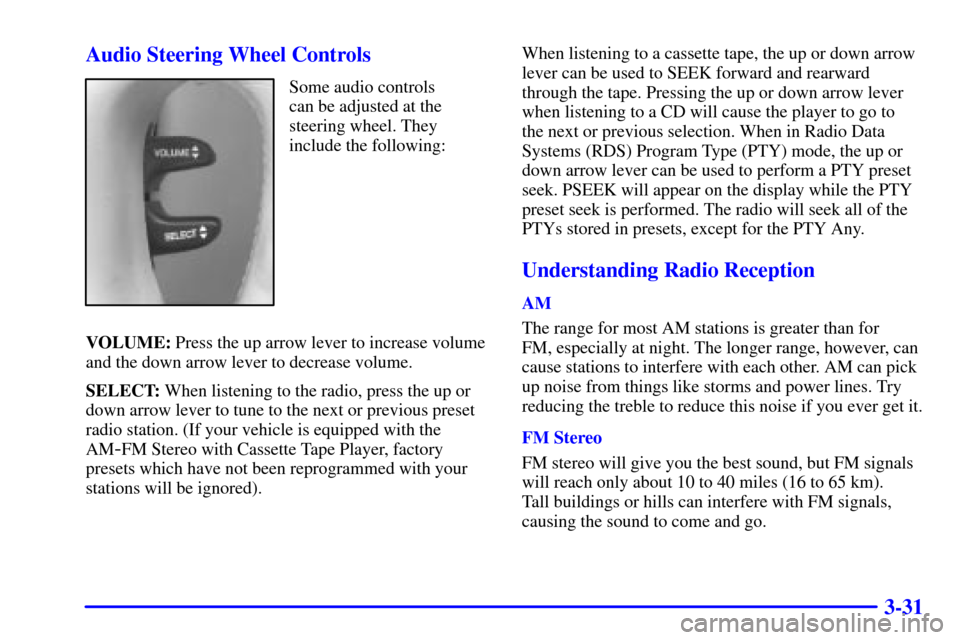
3-31 Audio Steering Wheel Controls
Some audio controls
can be adjusted at the
steering wheel. They
include the following:
VOLUME: Press the up arrow lever to increase volume
and the down arrow lever to decrease volume.
SELECT: When listening to the radio, press the up or
down arrow lever to tune to the next or previous preset
radio station. (If your vehicle is equipped with the
AM
-FM Stereo with Cassette Tape Player, factory
presets which have not been reprogrammed with your
stations will be ignored). When listening to a cassette tape, the up or down arrow
lever can be used to SEEK forward and rearward
through the tape. Pressing the up or down arrow lever
when listening to a CD will cause the player to go to
the next or previous selection. When in Radio Data
Systems (RDS) Program Type (PTY) mode, the up or
down arrow lever can be used to perform a PTY preset
seek. PSEEK will appear on the display while the PTY
preset seek is performed. The radio will seek all of the
PTYs stored in presets, except for the PTY Any.
Understanding Radio Reception
AM
The range for most AM stations is greater than for
FM, especially at night. The longer range, however, can
cause stations to interfere with each other. AM can pick
up noise from things like storms and power lines. Try
reducing the treble to reduce this noise if you ever get it.
FM Stereo
FM stereo will give you the best sound, but FM signals
will reach only about 10 to 40 miles (16 to 65 km).
Tall buildings or hills can interfere with FM signals,
causing the sound to come and go.
Page 184 of 335
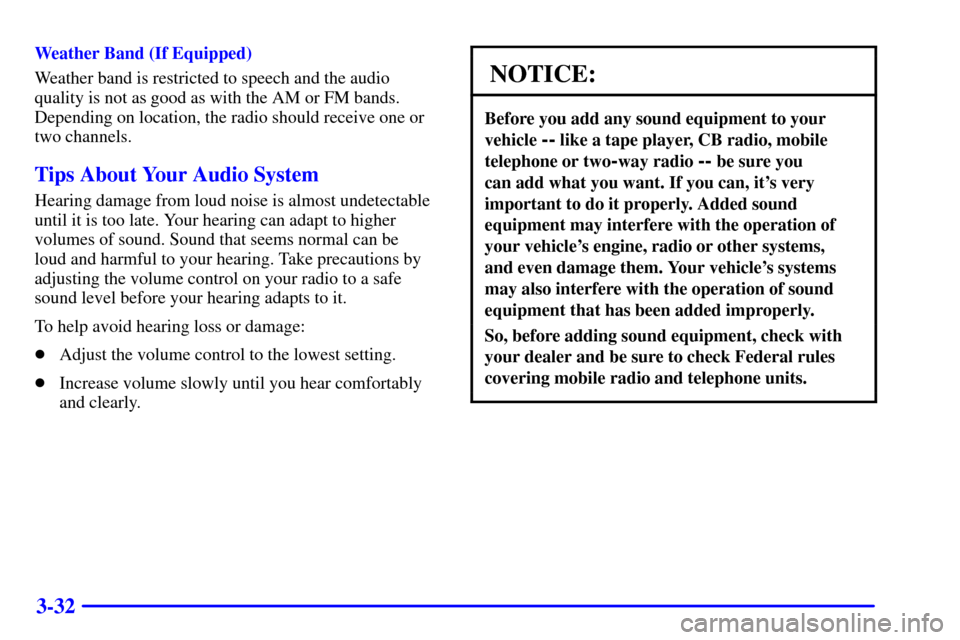
3-32
Weather Band (If Equipped)
Weather band is restricted to speech and the audio
quality is not as good as with the AM or FM bands.
Depending on location, the radio should receive one or
two channels.
Tips About Your Audio System
Hearing damage from loud noise is almost undetectable
until it is too late. Your hearing can adapt to higher
volumes of sound. Sound that seems normal can be
loud and harmful to your hearing. Take precautions by
adjusting the volume control on your radio to a safe
sound level before your hearing adapts to it.
To help avoid hearing loss or damage:
�Adjust the volume control to the lowest setting.
�Increase volume slowly until you hear comfortably
and clearly.
NOTICE:
Before you add any sound equipment to your
vehicle
-- like a tape player, CB radio, mobile
telephone or two
-way radio -- be sure you
can add what you want. If you can, it's very
important to do it properly. Added sound
equipment may interfere with the operation of
your vehicle's engine, radio or other systems,
and even damage them. Your vehicle's systems
may also interfere with the operation of sound
equipment that has been added improperly.
So, before adding sound equipment, check with
your dealer and be sure to check Federal rules
covering mobile radio and telephone units.
Page 185 of 335
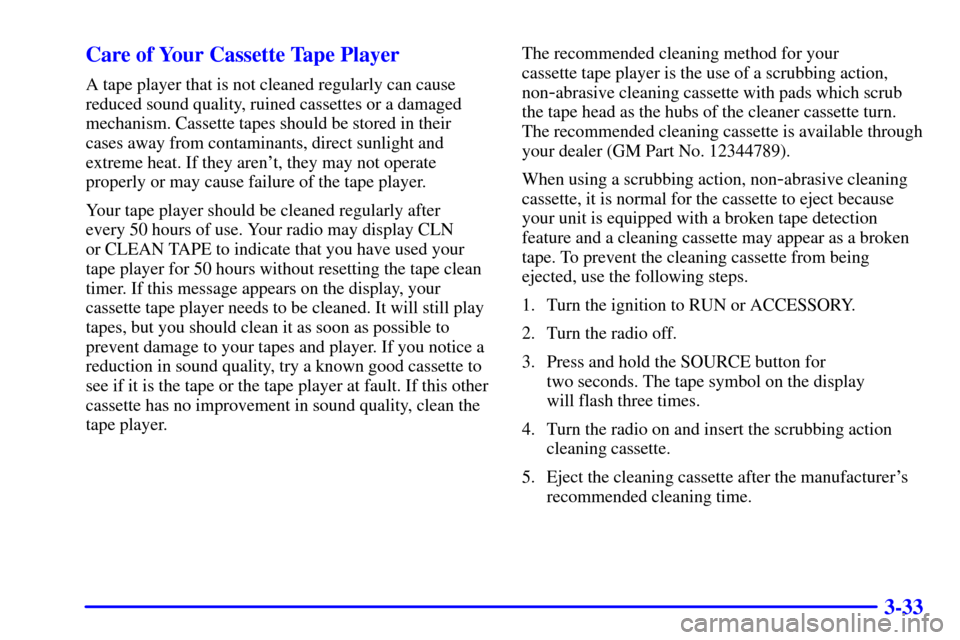
3-33 Care of Your Cassette Tape Player
A tape player that is not cleaned regularly can cause
reduced sound quality, ruined cassettes or a damaged
mechanism. Cassette tapes should be stored in their
cases away from contaminants, direct sunlight and
extreme heat. If they aren't, they may not operate
properly or may cause failure of the tape player.
Your tape player should be cleaned regularly after
every 50 hours of use. Your radio may display CLN
or CLEAN TAPE to indicate that you have used your
tape player for 50 hours without resetting the tape clean
timer. If this message appears on the display, your
cassette tape player needs to be cleaned. It will still play
tapes, but you should clean it as soon as possible to
prevent damage to your tapes and player. If you notice a
reduction in sound quality, try a known good cassette to
see if it is the tape or the tape player at fault. If this other
cassette has no improvement in sound quality, clean the
tape player.The recommended cleaning method for your
cassette tape player is the use of a scrubbing action,
non-abrasive cleaning cassette with pads which scrub
the tape head as the hubs of the cleaner cassette turn.
The recommended cleaning cassette is available through
your dealer (GM Part No. 12344789).
When using a scrubbing action, non
-abrasive cleaning
cassette, it is normal for the cassette to eject because
your unit is equipped with a broken tape detection
feature and a cleaning cassette may appear as a broken
tape. To prevent the cleaning cassette from being
ejected, use the following steps.
1. Turn the ignition to RUN or ACCESSORY.
2. Turn the radio off.
3. Press and hold the SOURCE button for
two seconds. The tape symbol on the display
will flash three times.
4. Turn the radio on and insert the scrubbing action
cleaning cassette.
5. Eject the cleaning cassette after the manufacturer's
recommended cleaning time.
Page 186 of 335

3-34
When the cleaning cassette has been ejected, the broken
tape detection feature is active again.
You may also choose a non
-scrubbing action, wet-type
cleaner which uses a cassette with a fabric belt to clean
the tape head. This type of cleaning cassette will not
eject on its own. A non
-scrubbing action cleaner may
not clean as thoroughly as the scrubbing type cleaner.
The use of a non
-scrubbing action, dry-type cleaning
cassette is not recommended.
If your vehicle is equipped with the AM
-FM Stereo with
Cassette Tape Player, press and hold the eject button for
five seconds to reset the CLN indicator after you clean
the player. The radio will display
--- to show the
indicator was reset.
If your vehicle is equipped with any other radio, press
and hold the eject button for three seconds to reset the
CLEAN TAPE indicator after you clean the player.
The radio will display CLEAN TAPE MSG CLEARED
to show the indicator was reset.Cassettes are subject to wear and the sound quality
may degrade over time. Always make sure the cassette
tape is in good condition before you have your tape
player serviced.
Care of Your Compact Discs
Handle discs carefully. Store them in their original cases
or other protective cases and away from direct sunlight
and dust. If the surface of a disc is soiled, dampen a
clean, soft cloth in a mild, neutral detergent solution
and clean it, wiping from the center to the edge.
Be sure never to touch the side without writing when
handling discs. Pick up discs by grasping the outer edges
or the edge of the hole and the outer edge.
Care of Your Compact Disc Player
The use of CD lens cleaner discs is not advised, due to
the risk of contaminating the lens of the CD optics with
lubricants internal to the CD mechanism.
Page 187 of 335
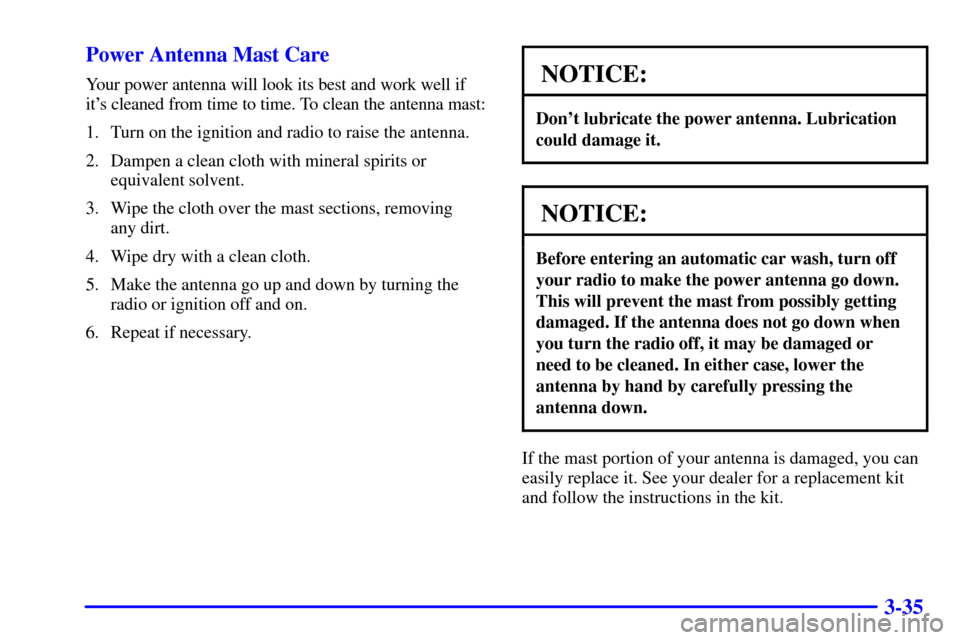
3-35 Power Antenna Mast Care
Your power antenna will look its best and work well if
it's cleaned from time to time. To clean the antenna mast:
1. Turn on the ignition and radio to raise the antenna.
2. Dampen a clean cloth with mineral spirits or
equivalent solvent.
3. Wipe the cloth over the mast sections, removing
any dirt.
4. Wipe dry with a clean cloth.
5. Make the antenna go up and down by turning the
radio or ignition off and on.
6. Repeat if necessary.NOTICE:
Don't lubricate the power antenna. Lubrication
could damage it.
NOTICE:
Before entering an automatic car wash, turn off
your radio to make the power antenna go down.
This will prevent the mast from possibly getting
damaged. If the antenna does not go down when
you turn the radio off, it may be damaged or
need to be cleaned. In either case, lower the
antenna by hand by carefully pressing the
antenna down.
If the mast portion of your antenna is damaged, you can
easily replace it. See your dealer for a replacement kit
and follow the instructions in the kit.
Page 228 of 335
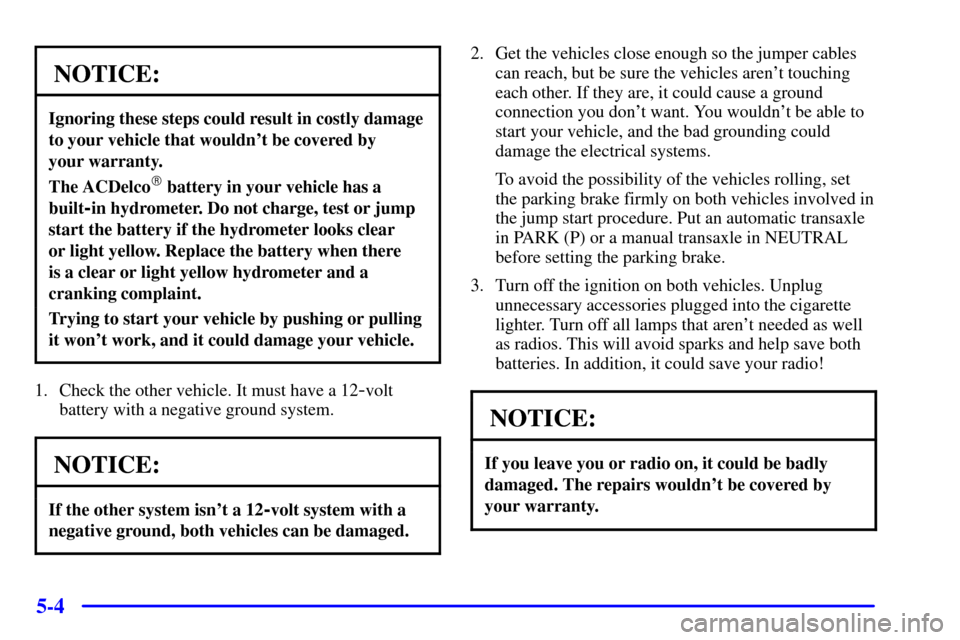
5-4
NOTICE:
Ignoring these steps could result in costly damage
to your vehicle that wouldn't be covered by
your warranty.
The ACDelco� battery in your vehicle has a
built
-in hydrometer. Do not charge, test or jump
start the battery if the hydrometer looks clear
or light yellow. Replace the battery when there
is a clear or light yellow hydrometer and a
cranking complaint.
Trying to start your vehicle by pushing or pulling
it won't work, and it could damage your vehicle.
1. Check the other vehicle. It must have a 12-volt
battery with a negative ground system.
NOTICE:
If the other system isn't a 12-volt system with a
negative ground, both vehicles can be damaged.
2. Get the vehicles close enough so the jumper cables
can reach, but be sure the vehicles aren't touching
each other. If they are, it could cause a ground
connection you don't want. You wouldn't be able to
start your vehicle, and the bad grounding could
damage the electrical systems.
To avoid the possibility of the vehicles rolling, set
the parking brake firmly on both vehicles involved in
the jump start procedure. Put an automatic transaxle
in PARK (P) or a manual transaxle in NEUTRAL
before setting the parking brake.
3. Turn off the ignition on both vehicles. Unplug
unnecessary accessories plugged into the cigarette
lighter. Turn off all lamps that aren't needed as well
as radios. This will avoid sparks and help save both
batteries. In addition, it could save your radio!
NOTICE:
If you leave you or radio on, it could be badly
damaged. The repairs wouldn't be covered by
your warranty.
Page 260 of 335
6-6
The fuel door release is
located above the radio on
the Driver Information
Center (DIC) and on
the remote keyless
entry transmitter.
This button works only when the shift lever is in PARK (P) or
NEUTRAL (N) and the VALET lockout switch is in OFF.
An alternate fuel door
release is located inside of
the trunk on the driver's
side. Pull it to release the
fuel door.While refueling, hang the cap by the tether from the
hook on the filler door.
To remove the cap, turn it slowly to the
left (counterclockwise). The cap has a spring in
it; if you let go of the cap too soon, it will spring back
to the right.
Page 314 of 335
6-60
MaxiFuse
(8
-Way) Usage
BODY 3 Controlled Power Relay,
Controlled Power Back
-Up Relay,
Cluster Fuse, Passenger Zone
Module (PZM) Fuse, Radio Fuse,
RAP Relay, Trunk and Fuel Door
Release Relay, High
-Beam Relay,
Comfort Fuse, AMP Fuse
(Optional), Right and Left Bose
Relay (Optional)
INADVERT Inadvertent Power Relay, Interior
Lamps Fuse, Cigarette Lighter
-1
Fuse, Courtesy Lamp Relay
LAMPS Headlamps Fuse/Relay, High/Low
Beam Control Relay, Fog Lamp
Fuse, DRL Fuse, Hazard Fuse,
Mirror Fuse, Inadvertent Power
Relay, Right and Left High
-Beam
Fuse, Right and Left Low
-Beam
Fuse, Stoplamp Fuse, Fog Lamp
Relay, DRL RelayMaxiFuse
(8
-Way) Usage
IGN 1 Rear Ignition
-1 Relay, Wiper
Fuse, Relay Ignition
-1 Fuse,
Supplemental Inflatable Restraint
(SIR) Fuse, Accessory Relay
WINDOWS Retained Accessory
Power (RAP) Relay
SEATS Horn Relay, Driver and Passenger
Lumbar In/Out Relays,
Driver and Passenger Lumbar
Up/Down Relays